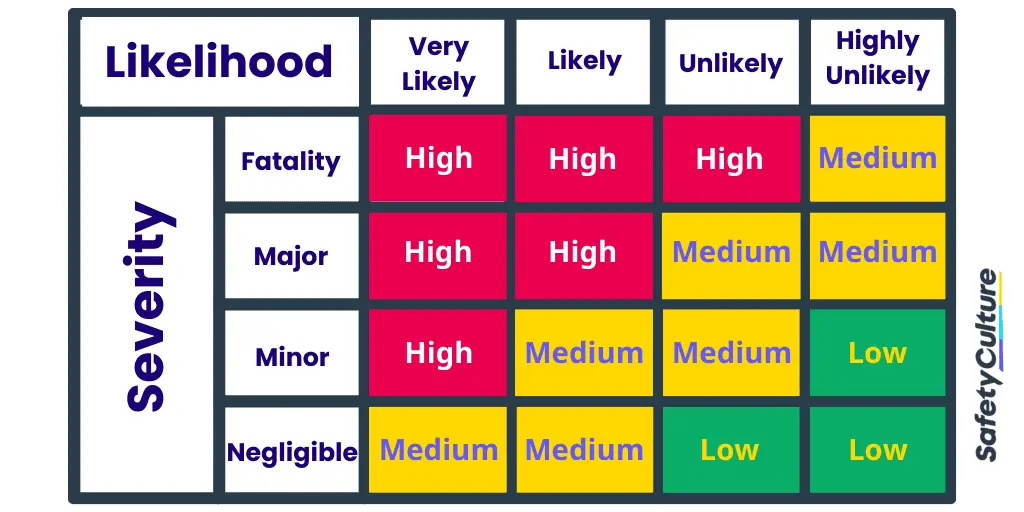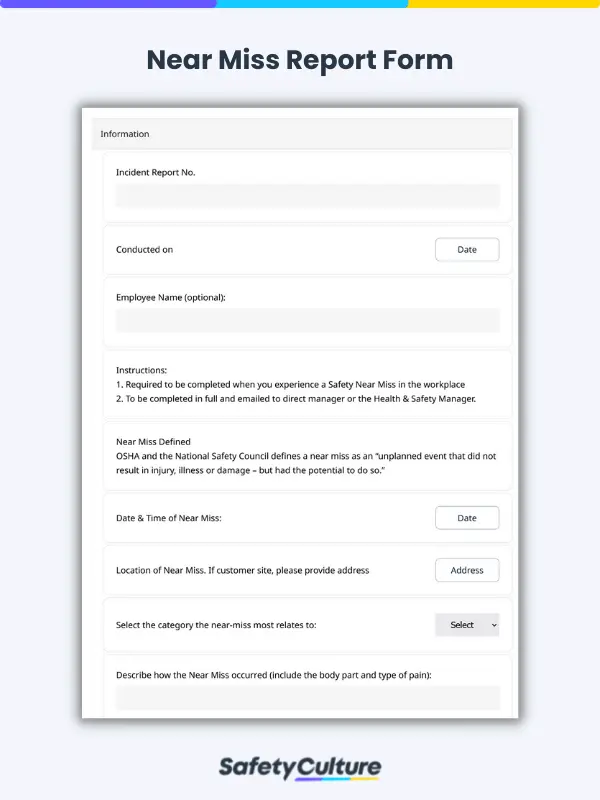What is a Near Miss?
A near miss is an incident that did not result in injury or property damage but would have if it had not been addressed in a timely manner. Though the worst possible outcomes of a near miss are not realized, affected employees should still report it as an unsafe event.
Difference Between Near Miss, Incident, and Accident
Near miss vs. incident
Though near miss is included in the OSHA definition of incident (as an incident subtype), a key difference between them is that the worst possible outcomes of an incident, which may or may not include injury or property damage, are realized due to it not being prevented or addressed in a timely manner.
For example, if the outcome of an unsafe event is fully realized and not prevented by luck or a last-minute decision, then the unsafe event is an incident, instead of a near miss, even if it also did not result in injury or property damage.
Near miss vs. accident
An accident is an unsafe event that results in injury or property damage. Though the OSHA definition of incident is essentially similar to accident, other safety organizations consider incident and accident to be two separate entities. A key difference between accidents and incidents (including a near miss) is that accidents are more complex, in that they do not have an apparent cause.
For example, if it is clear what caused the unsafe event to occur and its outcome includes injury or property damage, then the unsafe event is an incident, not an accident.
Why Organizations Should Never Ignore a Near Miss
An organization should pay attention to a near miss because it may have serious injury and fatality (SIF) potential. A near miss is classified as having SIF potential if the realistic worst outcome is a life-threatening or life-altering injury.
For example, an employee whose foot slips while climbing a ladder manages to regain his balance and not fall down the ladder. In this situation, the near miss has high SIF potential since 33% of deaths from falls in construction are caused by falls from ladders.
Importance
Though a near miss is sometimes deemed too trivial to be worth documenting, enforcing a near-miss report has many advantages. Timely reporting helps in mitigating risks, preventing accidents, raising awareness about the hazards employees face, and ensuring a safer working environment for them.
Requirements
OSHA doesn’t legally require companies to report near misses unless the incident resulted in injury or property damage. This is a common practice for employers to prepare a near miss report for safety management and incident recordkeeping.
Examples in the Workplace
Though near miss reporting is crucial in the construction industry, even corporate environments would benefit from setting up a near miss program. Below is a near miss example in the workplace:
An employee rushing to get to the cafeteria during his lunch break doesn’t see a large cable on the floor and trips on it. However, he notices that a table is nearby and uses it to stop himself from falling face-first onto the concrete floor.
If the employee decides to report the near miss: After the near miss, the employee tries to remove the large cable from the floor but is unable to. He submits a near miss report to the office manager, who is in charge of ensuring that employees have a safe space to work in. Upon receiving the near miss report, the office manager recognizes that the large cable is a safety hazard. She immediately enlists the help of other staff members to remove the large cable and they succeed. By the time the employee returns from his lunch break, the large cable is no longer on the floor but is propped up on a bench. It causes no further incidents.
If the employee chooses not to report the near miss: After the near miss, the employee continues speeding towards the cafeteria. He has his lunch and goes back to work, having forgotten about the near miss. A week passes by with the large cable still on the floor. About a week after the near miss, another incident occurs. However, this time the employee involved did not notice the table nearby and fell face-first onto the concrete floor. She takes the day off and goes to the emergency room to receive treatment for her injuries. Once there, the doctors inform her that she needs a week to recover. She ends up taking a leave of absence for the following week.
Steps for Setting Up a Successful Near Miss Program
A near miss program can be considered successful if it is integrated into or functions as the organization’s health and safety program. Isolating the near miss program from the wider organizational culture and other relevant policies may cause it to lose its effectiveness. To avoid implementing a faulty near miss program that becomes obsolete after a few months, follow the steps below:
Step #1 Ask Employees for Their Input
This can be done either formally via one-on-one interviews or informally via an online survey. In both cases, the health and safety team should ask employees the following questions:
- What are your thoughts on near miss reporting?
- What would stop you from reporting a near miss?
- What would encourage you to report a near miss?
- What do you think should be included in our near miss program?
- What would be your ideal form of participation in the near miss program?
Step #2 Perform Hazard Identification
This gives the health and safety team a general idea of what could possibly lead to a near miss. It also serves as training for conducting root cause analysis later on in the implementation of the near miss program. There are many types of hazards and some industries deal with specific types, such as chemical hazards in processing plants. The more common hazards, however, are safety hazards and ergonomic hazards.
Step #3 Perform Risk Assessment
Though risk assessment may include hazard identification, risk assessment focuses more on the possible consequences of a near miss, rather than possible causes. This step is crucial in spotting SIF potential even before a near miss occurs.

Risk Assessment Risk Matrix
By performing risk assessment before implementing the near miss program, the health and safety team gain a better understanding of the risks they should prioritize and prepare employees for.
Step #4 Have a Clear Implementation Plan
For any new policy, project, or program, the implementation phase either makes or breaks its success. Before jumping in though, it’s good to have a plan. When creating a plan for the implementation of the near miss program, the health and safety team must include representatives or leaders from different teams in the organization. This provides great insight on possible blockers to implementation and raises the credibility of the near miss program in the eyes of employees.
Improve your EHS Management
Cultivate a safe working environment and streamline compliance with our EHS solutions.
Explore nowTips for Successful Implementation
Once the plan for implementation has been finalized, the health and safety team can proceed with the implementation itself. While the specific steps for implementing a successful near miss program differ for each organization, here are a few basic tips that could help.
Tip #1 Conduct Regular Toolbox Talks
Though a near miss reporting toolbox talk should be held before implementation, regular toolbox talks after implementation may be necessary to ensure that employees fully understand the near miss program. Additionally, the health and safety team can use the feedback given by employees during these toolbox talks to improve the near miss program and its implementation.
Tip #2 Encourage Consistent Near Miss Reporting
Whenever a near miss occurs or is reported, it is critical to not place the blame solely on the employee, as the root cause of a near miss is more likely to be a flaw in the organization’s systems or processes. Another way to encourage near miss reporting is to emphasize how it benefits employees by giving real-life examples of how it prevented an injury or saved a life.
Tip #3 Provide Near Miss Reporting Forms
Save employees time spent on making near miss reports from scratch by providing near miss reporting forms that are easy to understand and fill out. A near miss reporting form should contain the following:
- Date, time, and location of the near miss
- Other details including the hazards involved
- Person affected by the near miss and witnesses
When creating templates for near miss reporting forms, consider adding questions on the SIF potential of the near miss and what prevented the near miss from resulting in injury or property damage.
Near Miss Reporting Form Template
Use this digital template to provide the necessary details and photo evidence of the near miss. Include the names of people who witnessed the near miss as well as a digital signature to validate the report before sending it to the health and safety team. Preview the near miss reporting form PDF.
Based on the Incident Investigation Form provided by OSHA in their Incident Investigation Guide for Employers, this digital template can be used to do the following:
- Preserve or document the scene
- Collect information
- Determine root causes
- Implement corrective actions
Quick Near Miss Reporting Form
Use this digital template to quickly document a near miss. Indicate if the near miss caused employees working in the area to stop work or if business-as-usual operations continued despite the near miss. Include the location, date, time, and additional photo/s to help explain the near miss. Preview the near miss reporting form PDF.
Create Your Own Near Miss Reporting Form
Eliminate manual tasks and streamline your operations.
Get started for FREETip #4 Use a Near Miss Reporting Tool
Paper near miss report forms take a while to complete and are easily misplaced after submission. With most risks being time-sensitive, preventing another near miss from occurring requires taking the proper corrective action immediately. Using a near miss reporting tool such as a mobile inspection app can help the health and safety team in addressing near misses in a timely manner.
SafetyCulture Features
SafetyCulture (formerly iAuditor) is a mobile inspection app that organizations across industries can use to protect the health and safety of their employees. As the Best SaaS Product for Health & Safety, SafetyCulture streamlines near miss reporting with the following features:
- Digital near-miss reporting form templates and more
- Automatically generated Web & PDF reports
- Analytics for safety issues and corrective actions




